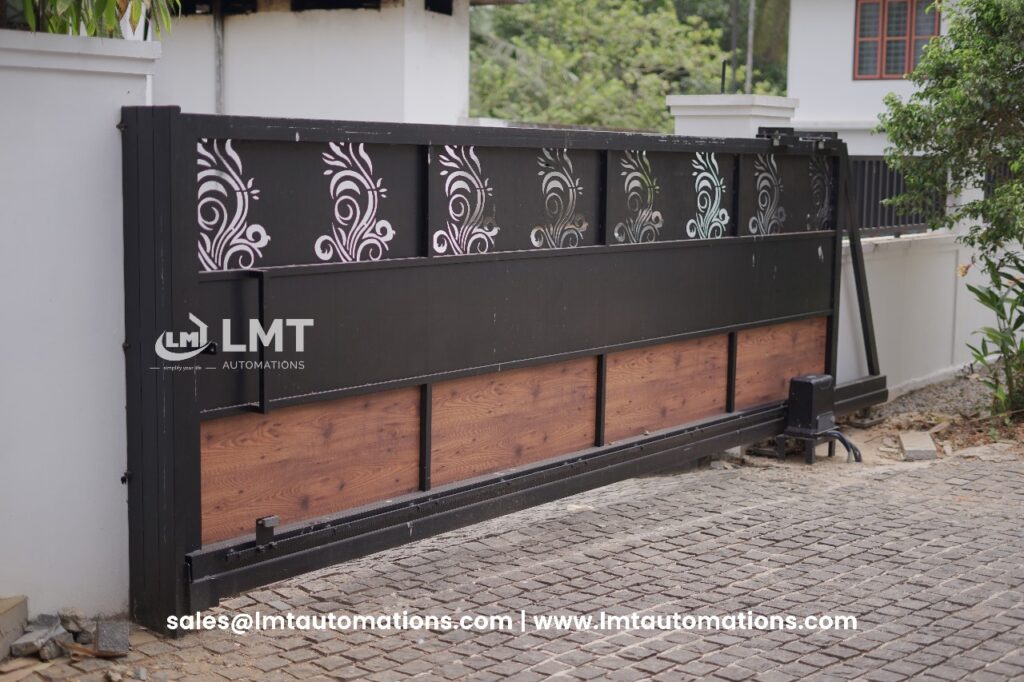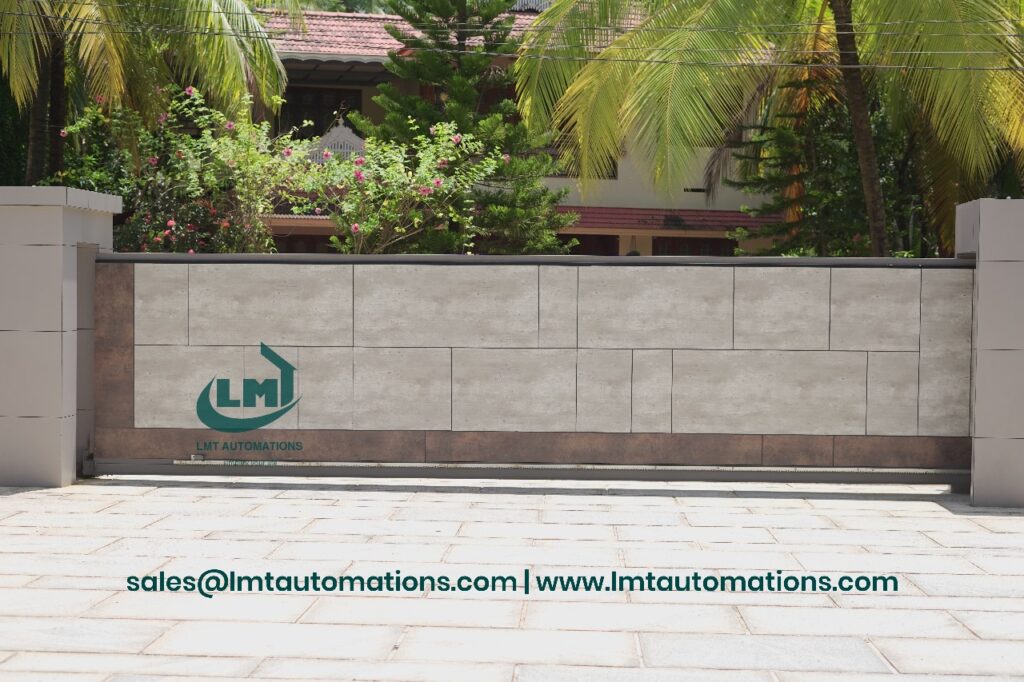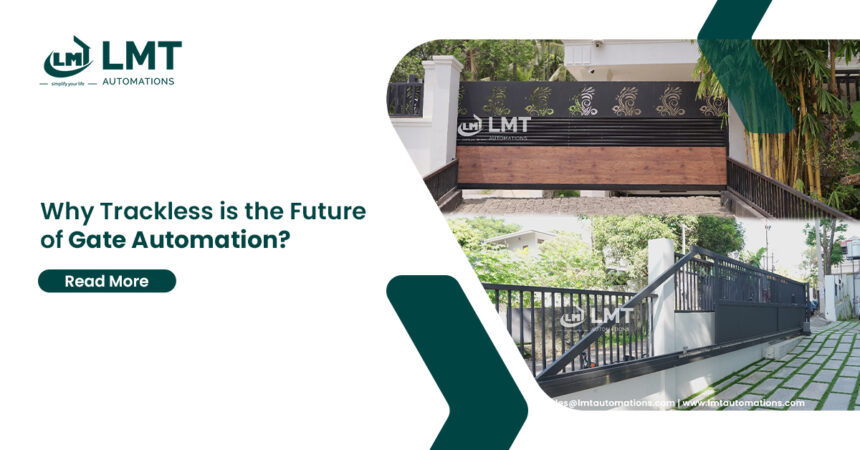When it comes to residential, commercial, or industrial gate systems, choosing the right type of gate can significantly impact not only the aesthetics and security of the property but also the long-term maintenance costs and installation complexity. Traditionally, sliding gates have been the go-to solution, especially for properties with horizontal space to spare. However, with advancements in gate automation and infrastructure design, the Cantilever sliding gate also referred to as a trackless sliding gate is emerging as a game-changing alternative.
In this comprehensive blog, we delve deep into the differences between Cantilever Trackless Gate Systems and Traditional Sliding Gates, focusing on critical aspects like installation, space usage, security, maintenance, cost, and design. If you’re a homeowner, business owner, or developer considering an automated gate solution, this guide will help you make an informed decision.

Cantilever Sliding Gate vs Traditional Sliding Gate: A Modern Upgrade
When choosing a gate system for residential, commercial, or industrial use, the decision often boils down to functionality, space, and durability. Traditional sliding gates, though reliable, come with limitations such as the need for ground tracks, higher maintenance, and more intensive civil work. In contrast, the cantilever sliding gate, often referred to as a trackless sliding gate, introduces a smarter alternative offering sleek design, simplified installation, and long-term performance benefits.
| Feature | Cantilever Sliding Gate (Trackless) | Traditional Sliding Gate |
| Installation | No ground track required; minimal civil work | Requires embedded ground track; more civil work and precision leveling |
| Groundwork | Non-intrusive; preserves driveway tiles or pavers | Involves breaking surface to lay tracks, which can damage flooring |
| Space Requirements | Ideal for tight, uneven, or sloped spaces | Needs a clean, level surface and lateral space for gate movement |
| Track Presence | Trackless – no debris or obstruction issues | Ground track accumulates dust, leaves, and debris |
| Maintenance Needs | Very low – no track to clean or align | Frequent – track cleaning, realignment, and rust prevention |
| Safety | No tripping hazard; safe for children, pets, and vehicles | Track can cause tripping; risky in high-traffic zones |
| Security | Difficult to tamper due to elevated design; better intrusion resistance | Ground track can be obstructed or tampered with |
| Operation | Smooth, silent, and friction-free | Prone to jerks or jamming if track is dirty or damaged |
| Aesthetic Appeal | Sleek, modern, and seamless look; hidden mechanics | Visible track and mechanical components may look industrial |
| Terrain Suitability | Suitable for any terrain (gravel, mud, slope, uneven surfaces) | Best on flat, well-paved surfaces only |
| Durability | Fewer moving parts exposed to the environment; long-lasting | Ground exposure causes more wear and tear |
| Automation Compatibility | Fully compatible with modern systems (remote, app, biometric, RFID) | Compatible, but frequent misalignment can hinder automation |
| Installation Time | Quick typically 1–2 days | Longer due to concrete work and track laying |
| Initial Cost | Slightly higher hardware cost but lower overall due to reduced civil work | Slightly lower hardware cost, but higher installation and maintenance |
| Long-Term Value | High reduced servicing, lower operational costs, minimal wear | Moderate requires regular upkeep and potential repairs |
1. Installation and Infrastructure Requirements
Cantilever Sliding Gate (Trackless Sliding Gate)
One of the most appealing advantages of a cantilever sliding gate is the minimal groundwork required for installation. Unlike traditional sliding gates, cantilever gates do not need a ground track. Instead, they are suspended above the ground, supported by a counterbalance system, and glide smoothly without touching the surface. This makes the installation process quicker, cleaner, and far less intrusive to your existing driveway or entrance.
Benefits:
- No need to cut or dig into the driveway.
- Reduced labor and civil construction work.
- No issues with waterlogging or poor drainage around tracks.
Traditional Sliding Gate
A traditional sliding gate requires a metal track to be embedded in the ground, which necessitates extensive groundwork and precise leveling. This process not only extends the installation time but can also lead to potential damage to driveways, tiled areas, or finished landscaping.
Drawbacks:
- Requires breaking existing pavement or concrete.
- Demands professional leveling to avoid future alignment issues.
- Vulnerable to poor ground conditions and long-term settling.
2. Space Requirements and Environmental Adaptability
Cantilever Sliding Gate (Trackless Sliding Gate)
Since cantilever gates are suspended and do not rely on ground tracks, they offer maximum efficiency in compact spaces. Their design prevents debris accumulation, making them ideal for areas with uneven ground, gravel driveways, or regions prone to mud and dust.
Ideal For:
- Residences with tight entrance spaces.
- Commercial spaces with frequent vehicle movement.
- Industrial zones with heavy equipment traffic or rough terrain.
Traditional Sliding Gate
While traditional sliding gates are functional, the requirement for a ground track makes them less adaptable. Debris, pebbles, and dirt can obstruct the track, disrupting smooth operation and necessitating regular cleaning.
Challenges:
- Not suitable for sloped driveways or muddy areas.
- More likely to get jammed due to environmental conditions.
- Requires more lateral space for full gate retraction.
3. Security and Safety Features
Cantilever Sliding Gate (Trackless Sliding Gate)
Security is often a top concern in any gate automation system. Cantilever gates offer enhanced security as they do not have ground tracks, making it more difficult for intruders to tamper with or lift the gate from its path. Moreover, the absence of a ground track eliminates tripping hazards, providing a safer passage for pedestrians, pets, and vehicles.
Key Safety Features:
- No exposed track to obstruct walking or driving.
- Smooth operation with fewer points of mechanical failure.
- Better resistance to forced entry attempts.
Traditional Sliding Gate
While still secure, traditional sliding gates present certain vulnerabilities. The ground track can be tampered with, blocked, or damaged, compromising the gate’s ability to function properly. Additionally, the exposed track can be a trip hazard, especially in homes with children or elderly residents.

4. Aesthetics and Design Versatility
Cantilever Sliding Gate (Trackless Sliding Gate)
Modern property owners are not just looking for functionality they want gates that look great too. Cantilever sliding gates provide a sleek, seamless, and modern look, thanks to the absence of a ground track and visible mechanical components. These gates can be easily customized to match various architectural styles, from minimalist to grandiose.
Aesthetic Advantages:
- Clean and uninterrupted driveway visuals.
- Sleek, floating appearance enhances curb appeal.
- Perfect for luxury homes, gated communities, and commercial buildings.
Traditional Sliding Gate
The visible ground track can detract from the elegance of a well-designed entrance. While customization is possible, traditional gates often appear more mechanical and dated compared to their cantilever counterparts.
5. Operation and Maintenance
Cantilever Sliding Gate (Trackless Sliding Gate)
Because cantilever gates operate above the ground, they experience less wear and tear and are generally easier to maintain. The absence of a track means fewer parts are exposed to environmental damage, and the motion is smoother.
Maintenance Benefits:
- Less frequent servicing required.
- Minimal parts prone to rust or misalignment.
- Long-lasting performance with simple upkeep.
Traditional Sliding Gate
In contrast, ground tracks need to be cleaned regularly to ensure smooth motion. If the track gets bent, misaligned, or clogged, the gate can become noisy, slow, or stuck resulting in higher maintenance costs.
6. Cost Comparison and Long-Term Savings
Cantilever Sliding Gate (Trackless Sliding Gate)
One of the standout benefits of choosing a cantilever sliding gate is the significant cost savings over time. Because it does not require ground tracks, the need for extensive civil work, alignment, and additional materials like concrete is eliminated. This translates to an immediate cost reduction of ₹35,000–₹40,000 on installation alone.
Additionally, the low-maintenance nature of cantilever gates ensures long-term savings on repairs and service calls.
Cost Benefits:
- Lower installation charges.
- Reduced construction materials and labor costs.
- Lower lifetime maintenance expenses.
Traditional Sliding Gate
While the initial cost of a traditional gate may appear slightly lower in terms of hardware, the civil work and maintenance add up quickly. Factors like weather damage to the track, frequent realignments, and cleaning contribute to ongoing operational costs.
7. Use Cases and Real-World Applications
Cantilever Sliding Gate (Trackless Sliding Gate)
- Residential: Gated villas, apartment complexes, private driveways.
- Commercial: Office campuses, malls, tech parks.
- Industrial: Warehouses, factories, logistics centers.
Traditional Sliding Gate
- Residential: Older housing layouts with level, paved driveways.
- Commercial: Properties where existing infrastructure already supports ground tracks.
- Industrial: Applications where frequent heavy-duty usage justifies robust ground systems (with frequent maintenance).
Conclusion: A Smarter, Safer, and Sleeker Gate Solution
Choosing the right gate system is about more than just access control it’s about enhancing security, preserving aesthetics, and minimizing maintenance. The Cantilever Trackless Sliding Gate System from LMT Automations offers a superior alternative to traditional sliding gates with its trackless design, minimal groundwork, and effortless operation. Perfect for both residential and commercial applications, this gate solution eliminates the hassles of ground tracks while delivering unmatched performance on any terrain.
Whether you’re dealing with sloped driveways, premium stone paving, or unpredictable ground conditions, the Cantilever Gate System ensures long-term reliability and low maintenance costs all while providing a modern look and seamless automation compatibility.
👉 Ready to upgrade your property’s entrance?
Get in touch with our team today for expert consultation, site assessment, and a customized solution that fits your space and budget.
📞 Call us or 📩 Contact Us to learn more about the future of gate automation powered by LMT Automations.
FAQs
1. What is a cantilever sliding gate?
A cantilever sliding gate is a gate system that operates without touching the ground. It slides sideways using a suspended mechanism supported by rollers and a counterbalance, making it ideal for uneven or debris-prone surfaces.
2. Why is it called a trackless sliding gate?
It’s called trackless because it does not require a ground track for movement. This eliminates issues like dirt accumulation, water logging, and wear-and-tear commonly seen in traditional sliding gates.
3. How does a cantilever gate differ from a traditional sliding gate?
Cantilever gates operate above the ground with no track, requiring less civil work and offering smoother, low-maintenance operation. Traditional sliding gates use a ground track, which can accumulate debris and need frequent cleaning and alignment.
4. Is a cantilever sliding gate suitable for all weather conditions?
Yes. Because it doesn’t rely on ground contact, cantilever gates perform well even in areas prone to rain, snow, mud, or dust. They are especially effective in industrial or coastal regions.
5. Can a cantilever gate be automated?
Absolutely. Cantilever gates are fully compatible with modern automation systems. Many models support remote control, keypad access, and mobile app integration.
6. Is a cantilever gate more secure than a traditional gate?
Yes. Cantilever gates are harder to tamper with due to the absence of a ground track. They offer fewer mechanical vulnerabilities and often include advanced locking systems for added security.
7. What kind of maintenance does a cantilever gate require?
Minimal. Since there is no track on the ground, there’s less cleaning and no risk of rust, misalignment, or debris blockage. Routine checks on rollers and lubrication are sufficient.
8. Can cantilever gates be customized for residential and commercial use?
Yes. They come in various styles, materials (steel, aluminum), and finishes. Whether you want a sleek modern look for a villa or a heavy-duty setup for an industrial park, they can be customized accordingly.
9. What are the cost savings with a cantilever sliding gate?
Homeowners and developers can typically save ₹35,000 to ₹40,000 or more in civil work and installation costs compared to traditional gates. Long-term maintenance savings add even more value.
10. How long does installation take for a cantilever sliding gate?
Installation is relatively quick usually 1 to 2 days since there is no need for ground excavation or concrete work. This also minimizes disruption to daily activities.
11. Are cantilever gates safe for homes with children and pets?
Yes. With no tracks on the ground, there are no tripping hazards. The smooth and controlled movement also reduces the risk of injury.
12. What type of motor or automation system is used for cantilever gates?
Most cantilever gates use sliding gate motors with high torque output. Italian automation brands like Genomatic are commonly used for their reliability and performance.
13. Do cantilever gates work on sloped or uneven ground?
Yes. Unlike track-based gates that require a level surface, cantilever systems perform well on sloped or uneven terrains, making them perfect for hilly or rough landscapes.
14. Can a cantilever gate be integrated with home automation or access control systems?
Definitely. Cantilever sliding gates can be seamlessly integrated with intercoms, RFID card systems, biometric access, and mobile apps offering full smart gate functionality.
15.Is the Cantilever Trackless Sliding Gate System available with LMT Automations?
Yes, absolutely. LMT Automations offers advanced Cantilever Trackless Sliding Gate Systems designed for both residential and commercial applications. Our solutions are engineered for Indian conditions and come with expert installation support.


Leave a Reply